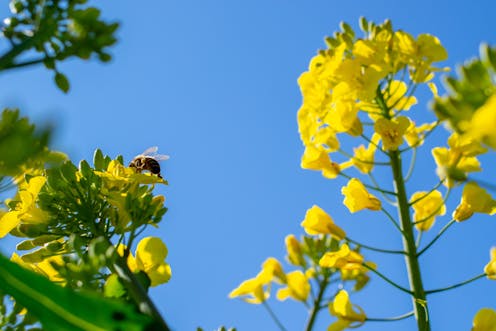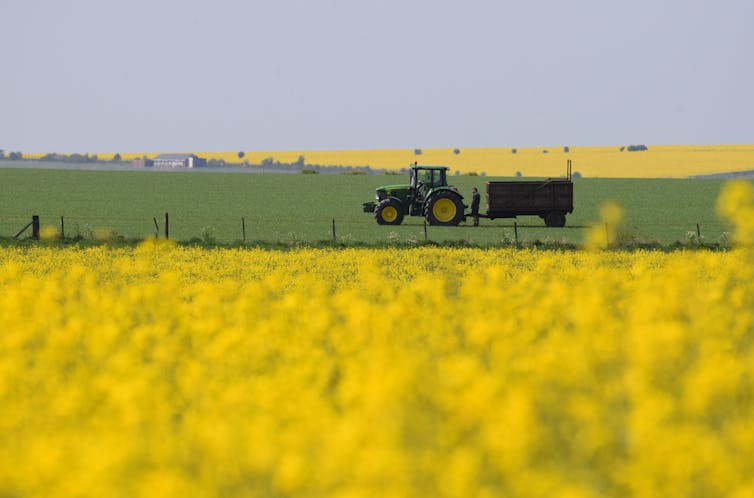
Where once there were vast areas of forest and other natural habitats, farmland now covers much of Earth – including 70% of the UK. This transition has helped feed a growing number of people.
However, replacing ecosystems rich in species with agriculture – and intensifying food production on established farmland – carries costs for the environment and wildlife. Worldwide, insect populations are declining rapidly.
Farming schemes that alleviate this damage are being devised, including the UK government’s 2023 sustainable farming incentive. Among other things, this will aid bees and other flower-visiting insects. These insects are a substantial part of biodiversity (the UK has roughly 260 species of bee) and pollinate many wildflowers and crops. One incentive under the scheme pays farmers and managers to spare some land for nature by planting wildflower seeds.
But what if there was a way to help pollinators at no cost, without removing land from food production? One idea has considerable potential: breeding and using crop varieties to produce more nectar and pollen to feed insects. We set out to test it.
The cream of the crop
In one experiment, we found that some varieties of the same crop are better at attracting insects than others. Our simple method could be used to identify more insect-friendly varieties when breeding and trialling crops.
We studied a trial by a seed company near Evesham in the English West Midlands, which demonstrated the merits of different red clover varieties to farmers. We took advantage of this trial to find out which variety provided most bee food, by counting the flowers and the bees foraging on them.

Red clover is largely grown to produce food for grazing animals. Symbiotic bacteria in the plant’s roots also put nitrogen into the soil, reducing the need for man-made nitrogen fertiliser, which can cause water pollution and uses a lot of energy when being produced from nitrogen in the air.
We found huge variation in the numbers of pollinators per variety – 50 times between the highest and lowest. The vast majority (87%) of the insects we saw were bumble bees. Of the flower traits we measured (number of flowers per square metre, their length, and the amount of nectar sugar produced per flower), only the number of flowers significantly influenced the abundance and diversity of insects.
So, would it be worth breeding crop varieties to enhance their nectar production? In another study, we showed that it largely depends on the time of year the crop blooms.
Oilseed rape is the UK’s third-biggest arable crop, providing oil for cooking and other uses. Fields of its yellow flowers are a familiar sight in Britain, where it is mostly grown from seeds sown the previous autumn or late summer, to flower in spring and harvest in summer. But it can also be planted in spring to flower in summer.
We studied farmers’ fields of spring-blooming oilseed rape (30 hectares on average) across Sussex in southern England. We counted the insects and flowers and, by bagging flowers and collecting fallen ones, determined how much of the nectar and pollen produced by these plants was not collected by insects. The insects were honey bees (79%), bumble bees (19%), other bees (3%), and other insects (6%).
Most of the nectar (69%) was not gathered. Although flowers may reabsorb uncollected nectar, this is wasted as bee food. Pollen wastage was less severe at 19%. However, oilseed rape is partially wind-pollinated, so some pollen may have been blown from the flowers. It is unlikely that bees collected all 81%.
What we learned
Why is so much oilseed rape nectar wasted? First, spring is a good season for bee foraging, with many flowers and few insects. Bumble bee colonies, for example, are being established at this time of year by queens and have few bees, while honey bee colonies are also smaller and less numerous than in summer.

Summer is the most challenging foraging season for bees. Previous research has shown that honey bees forage much closer to the hive in spring than summer, and do not forage in oilseed rape fields more than 1.5km away – even though they can forage as far as 12km from the hive. A large oilseed rape field probably also provides more pollen and nectar than local insects need.
So, our two studies have different things to say about breeding crops to produce more nectar and pollen.
Firstly, red clover blooms in summer, a challenging season for flower-visiting insects, and hence a more useful time for crops that produce additional nectar to bloom.
In contrast, as 95% of oilseed rape grown in Britain is spring-blooming, breeding it to produce more nectar may have little conservation benefit. However, further research could determine if wastage is lower for summer-blooming oilseed rape. If so, greater nectar production may be worthwhile.
One way to help wildlife would be to revert farmland to natural ecosystems. But another is to find ways to produce food that also helps wildlife. Growing and breeding crop varieties that produce more nectar and pollen is one such win-win possibility. Importantly, the quantities of nectar and pollen are small compared with the crop’s overall biomass, so wouldn’t make much of a difference to the yield.
Governments could offer incentives for planting more bee-friendly crop varieties. But it may even be enough to tell farmers which varieties produce more nectar and pollen. In our experience, most farmers want to help bees and recognise their importance. Many may be unaware that what feeds livestock can also feed bees.

Don’t have time to read about climate change as much as you’d like?
Get our award-winning weekly roundup in your inbox instead. Every Wednesday, The Conversation’s environment editor writes Imagine, a short email that goes a little deeper into just one climate issue. Join the 40,000+ readers who’ve subscribed so far.
Ciaran Harris receives funding from the Elizabeth Creak Charitable Trust.
Francis Ratnieks does not work for, consult, own shares in or receive funding from any company or organisation that would benefit from this article, and has disclosed no relevant affiliations beyond their academic appointment.
This article was originally published on The Conversation. Read the original article.







